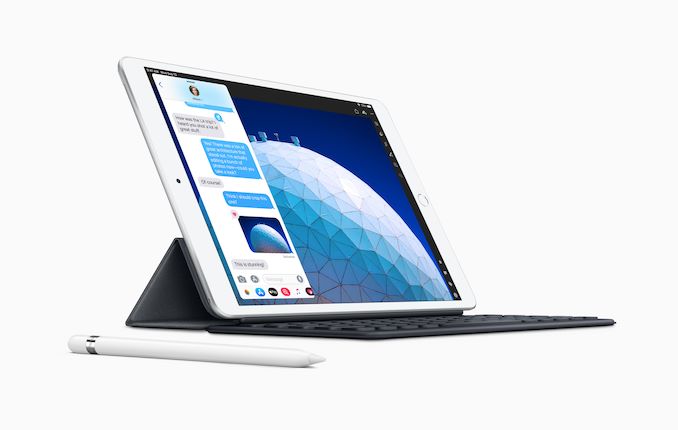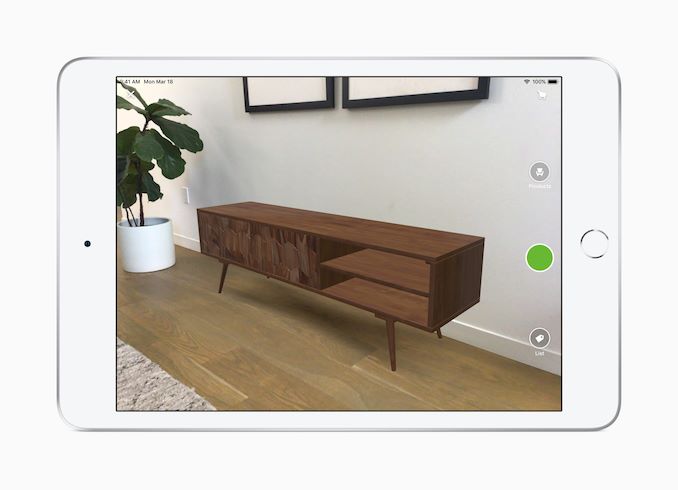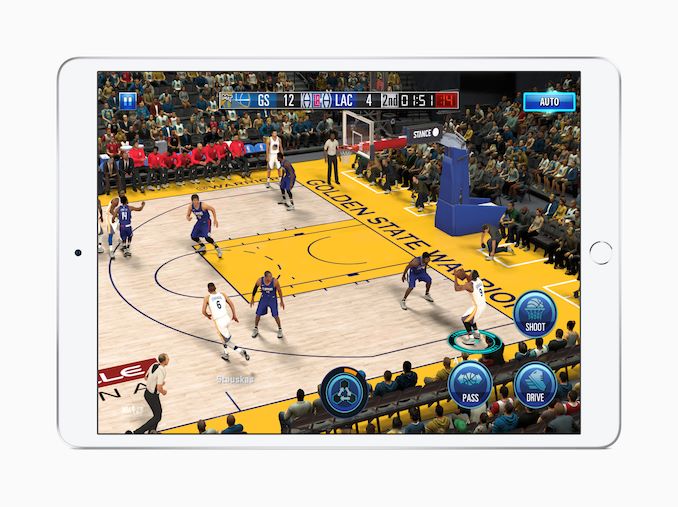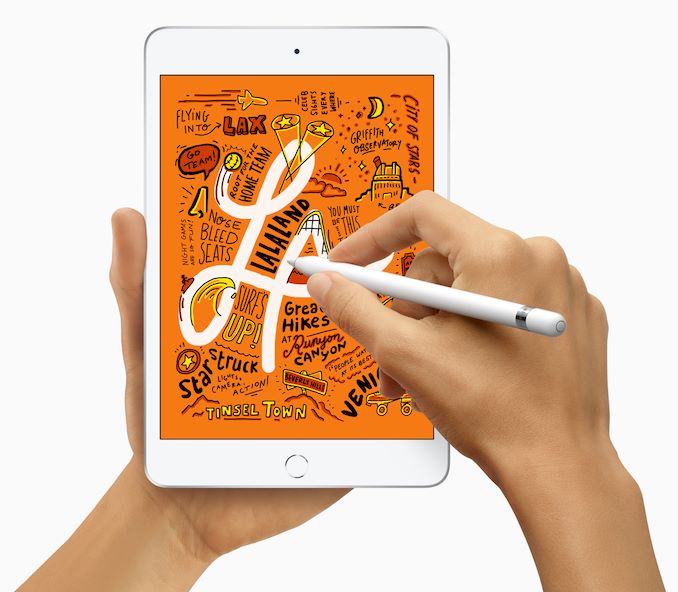Apple Announces New 10.5" iPad Air, 7.9" iPad mini
by Andrei Frumusanu on March 18, 2019 11:30 AM EST
Today in a surprise announcement, Apple has unveiled refreshes to both the iPad Air and iPad mini lineups. The last releases in the lineups were the iPad Air 2 and iPad mini 4 back in 2015. We had thought Apple had abandoned the models, yet today’s release now breathes fresh air into the devices with much needed internal hardware upgrades as well as new functionality.
| Apple iPad Comparison | ||||
| iPad Air 2 | iPad mini 4 | iPad Air (2019) | iPad mini (2019) | |
| SoC | Apple A8X 3 x Typhoon @ 1.5GHz |
Apple A8 2 x Typhoon @ 1.5GHz |
Apple A12 Bionic 2 × Vortex @ 2.5GHz 4 × Tempest @ 1.59GHz |
|
| Display | 9.7" 2048x1536 IPS LCD | 7.9" 2048x1536 IPS LCD | 10.5" 2224x1668 IPS LCD DCI-P3, True Tone |
7.9" 2048x1536 IPS LCD DCI-P3, True Tone |
| Dimensions | 240 x 169.5 x 6.1mm 437g |
203.2 x 134.8 x 6.1mm 298.8g |
250.6 x 174.1 x 6.1mm 456g / 464g |
203.2 x 134.8 x 6.1mm 300g / 308.2g |
| RAM | 2GB LPDDR3 | 2GB LPDDR3 | ? | ? |
| NAND | 16 / 64 / 128GB | 64 / 256GB | ||
| Battery | 27.3Wh | 19.1Wh | 30.2Wh | 19.1Wh |
| Front Camera | 1.2MP, F/2.2 | 7MP, F/2.2 | ||
| Rear Camera | 8MP, F/2.4, 1.1 micron | 8MP, F/2.4 | ||
| Cellular | 2G / 3G / 4G LTE (Category 9) | UE Category 16 LTE (1Gbps) with 4x4 MIMO and LAA | ||
| SIM Size | NanoSIM | NanoSIM + eSIM | ||
| Wireless | 802.11a/b/g/n/ac 2x2 MIMO, BT 4.2 LE, GPS/GLONASS |
802.11a/b/g/n/ac 2x2 MIMO, BT 5.0 LE, GPS/GLONASS |
||
| Connectivity | Apple Lightning 3.5mm headphone |
Apple Lightning 3.5mm headphone |
||
| Launch OS | iOS 9 | iOS 12 | ||
| Launch Price | $499 (16G) $599 (64G) $699 (128G) |
(Wifi / Cellular) $399/$529 (16G) $499/$629 (64G) $599/$729 (128G) |
(Wifi / Cellular) $499/$629 (64G) $649/$779 (256G) |
(Wifi / Cellular) $399/$529 (64G) $549/$679 (256G) |
On the internal hardware side, both the new iPad Air (2019) and the new iPad mini (2019) make use of Apple’s new 7nm A12 chipset, which we’ve already seen in the iPhone XS and XR models. The A12X’s increased performance thus remains exclusive to the iPad Pro models this year.
The new iPad mini doesn’t change its design from its predecessor, which might not be to everybody’s liking in 2019 as the rather big bezels do feel a bit out of place compared to other newer tablets. While the design hasn’t seen an update, the 7.9” 2048x1536 IPS display will see some significant changes as it now supports Display P3 as well as True Tone.
The new iPad Air on the other hand does see significant design changes with a slight reduction in bezels, offering more screen estate. The new display comes now in a 10.5” diameter and increases the resolution to 2224x1668. Similarly to the new iPad mini, it also now supports P3 wide gamut content as well as True Tone.
The new Air is ever so slightly bigger than its predecessor, being 10mm taller, 4.6mm wider and 19g heavier. The new battery does increase from 27.3Wh to 30.2Wh.
Interestingly both devices still come with the home button and its capacitive fingerprint sensor, as well as 3.5mm headphone jack (not that we're complaining), so this is probably Apple’s purest hardware-only refresh ever.
The one single big new feature about the new iPads is that the devices are now compatible with the Apple Pencil. It’s to be noted we’re talking about the first generation Pencil, and not the second-generation unit we find in 2018’s new iPad Pros.
Overall, it’s interesting to see Apple refresh the iPad line-up, especially the often forgotten iPad mini. Apple’s reluctance to make any major design changes to the products, even 4 years on is quite odd, but then again if it isn’t broken, don’t attempt to fix it.
The new iPad mini and iPad Air come in 64 and 256GB variants, starting at $399 for the iPad mini and $499 for the iPad Air. The extra storage costs you $150, and added cellular connectivity adds another $130.
Related Reading
- The Apple iPhone XR Review: A Different Display Leads To Brilliant Battery Life
- The 2018 Apple iPad Pro (11-Inch) Review: Doubling Down On Performance
- The iPhone XS & XS Max Review: Unveiling the Silicon Secrets
- Hands On With the Apple 9.7 Inch iPad Pro
- The Apple iPad Pro Review
- The Apple iPad Mini 4 Review
- The Apple iPad Air 2 Review













74 Comments
View All Comments
Oliseo - Thursday, June 20, 2019 - link
And Google is enough to ditch Android. I used to be an Android fan like you, then I realised my privacy was more important to me than blind loyality to a multinational corporation that doesn't value me as a person.jordanclock - Monday, March 18, 2019 - link
Even as a huge Android fan, I can't recommend Android tablets at all for the most part. If someone wants one, I would suggest ChromeOS every time.HStewart - Monday, March 18, 2019 - link
I feel differently, I mostly been Apple phone and tablet - but when I got my first Samsung Tablet, I like it a lot and later got a Tab S3 and decided to get a Samsung Note 8 switch from iPhone 6 which started from iPhone 3.I would not consider a ChromeOS device - it just a waste of Power for such device. One thing I don't understand about ChromeOS is why has not Qualcomm power be put on it - it sound perfect on it - why waste to trying x86 emulation on it.
ztrouy - Tuesday, March 19, 2019 - link
To my understanding (and I could be remembering entirely wrong) from articles in the past discussing it, Qualcomm refused to provide the longterm support that Google required for the hardware. Too many portions of the stack were Qualcomm specific, and they wouldn't open it up for others like Google to update it, so they decided to not bother.jordanclock - Tuesday, March 19, 2019 - link
ChromeOS is not a waste of power. It runs Android and a Linux container. The UI is designed for a tablet or small laptop display.Android on tablets is a mashup of phone UI scaled up to a larger display and UI changes that make no sense in the context of a tablet. Google has put essentially zero effort into Android on tablets. Samsung has done a bit to extend the usability but I cannot think of a single task that an Android tablet excels at compared to an iPad other than being cheap enough that you won't be as upset when your kid wrecks it.
jordanclock - Tuesday, March 19, 2019 - link
Also, I don't know what you mean by x86 emulation. Android on ChromeOS runs x86 apps. There is no emulation.Tams80 - Wednesday, March 20, 2019 - link
A blown up phone UI works fairly well on the average sized tablet. Not to mention that a fair number of developers have made apps that scale well.A shrunk down desktop environment is horrible. Usable with a stylus, but below 10" not fun.
Wasabi_Vengeance - Monday, March 18, 2019 - link
Really? Because you're pretty much guaranteed 4+ years of security updates for an iPad, vs android tablets where you're lucky to get 2 years. And after 2 years, an A12-based tablet is still likely to be faster than the newest android tablets.abufrejoval - Wednesday, March 20, 2019 - link
That's why you need an open platform to use Custom ROMs.I have a Nexus 10 that recently celebrated its 6th birthday and launched on Jelly Beans while it is now running Oreo while I'm pretty sure it will get a Pie or even a Q.
Sure, it's not super fast (never was a gaming device), but great for reading books, movies and surfing (Opera!) and on its second easily exchanged OEM battery it still lasts way more hours than I need.
I even used it as a desktop replacement with BT keyboard and mouse when I was in hospital a couple of years ago and whenever it ran out of steam locally, I just switched to an RDP session running on my home PC.
Best of all, it still has an honest-to-God micro-HDMI connector so I could hook it up to the TV for watching movies.
XVIIONE - Monday, December 30, 2019 - link
Funny, my Nexus 7 lost support at Marshmallow and even Lineage OS doesn’t support the Nexus 7(2013) so I am stuck at Nougat and apps hardly work well. Pretty sure the Nexus 10 lost support the same time. I got a iPad Mini 2019 as the Micro-USB port died and I can tell you, I tried the Android tablets first but nothing was as good in the size range full stop.